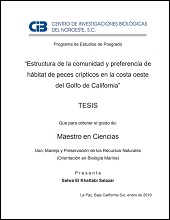Estructura de la comunidad y preferencia de hábitat de peces crípticos en la costa oeste del Golfo de California
Abstract
"Gran parte de los peces asociados a los arrecifes son de naturaleza críptica. Debido a su importancia, es necesario comprender la dinámica de las asociaciones entre peces crípticos y los diferentes hábitats arrecifales, así como con el ambiente. El Golfo de California (GC) se caracteriza por presentar una complejidad tanto geográfica como oceanográfica, la cual influye y modula el patrón de distribución de las especies que lo habitan. Los estudios enfocados a la ecología de las comunidades de peces crípticos son escasos o desarrollados en áreas geográficas pequeñas, lo cual dificulta inferir los patrones de estructura de la comunidad y su asociación con el hábitat y el ambiente. El objetivo del presente trabajo fue describir la estructura de la comunidad y la preferencia de hábitat de los peces crípticos a lo largo del gradiente ambiental latitudinal de la costa oeste del Golfo de California. Se realizaron muestreos en 27 sitios considerando diferentes sustratos y profundidades. En total, 2,827 organismos fueron recolectados e identificados, pertenecientes a veinte familias y 82 especies. Las familias Gobiidae y Labrisomidae presentaron el mayor número de especies. Once familias estuvieron asociadas a todos los tipos de hábitat, tres familias se encontraron únicamente en el arrecife rocoso y el arrecife coralino; y seis familias fueron exclusivas del arrecife rocoso. Las cuatro especies más abundantes corresponden a A. crockeri, E. puncticulatus, E. reticulatus y L. dalli. A partir del análisis de agrupamiento jerárquico se pudieron delimitar tres diferentes regiones en el Golfo de California: Sur, Centro y Norte de acuerdo a la composición comunitaria de peces crípticos. El análisis de la estructura de las comunidades se realizó a través de los índices de diversidad tradicionales: Margalef, Shannon–Wiener y Pielou; y de los índices de Diversidad taxonómica. Se observó una tendencia en la que la riqueza y la diversidad de especies disminuyen de Sur a Norte. La región Centro fue la de mayor diversidad y riqueza, mientras que en la región Sur se obtuvo la mayor equitatividad y distintividad taxonómica. Las especies típicas de la región Sur están relacionadas positivamente con la temperatura superficial y negativamente con la concentración de clorofila, mientras que esto se observó a la inversa para las especies típicas de la región Norte..." "Much of the fish associated with the reefs are of a cryptic nature. Due to its importance, it is necessary, to know the dynamics of the associations between the cryptic fishes and the different reef habitats, as well as with the environment. The Gulf of California (GC) is characterized by its geographical and oceanographic complexity, which influences and modulates the distribution pattern of the species that inhabit it. The studies focused on cryptic fishes’ community ecology are scarce or focused in small geographic areas, which hinders the patterns of community structure and its association with habitat and environment. The objective of the present work was to describe the community’s structure and the habitat preference of the cryptic fishes along the environmental gradient of the west coast of the Gulf of California. Samples were taken in 27 sites considering different substrates and depths. In total, 2,827 organisms were collected and identified, belonging to twenty families and 82 species. The families Gobiidae and Labrisomidae had the highest number of species (fifteen), followed by the family Chaenopsidae (eleven). Eleven families had an association with all three habitat types, three families were found on the rocky reef and coral reef; and six families were exclusive to the rocky reef. The four most abundant species correspond to A. crockeri, E. puncticulatus, E. reticulatus and L. dalli. From the analysis of hierarchical grouping, three different regions were defined in the Gulf of California: South (Punta Sur, Saltito and San Evaristo) Middle (Agua Verde, San Cosme, Bahía Concepción and Santa Rosalía) and North (Puerto San Francisquito, Bahía de los Ángeles and San Luis Gonzaga) according to the cryptic fishes’ community composition. The structure of the communities’ analysis was carried out through the traditional indexes of diversity: Margalef, Shannon-Wiener and Pielou; and the Taxonomic Diversity indexes. A trend was observed in which species richness and diversity decrease from South to North. The Central region was the one with the greatest diversity and richness, while in the South region the greatest taxonomic uniformity and distinctiveness was obtained. The typical species of the South region were positively related to the surface temperature and negatively related to the chlorophyll, while this was observed in reverse for the typical species of the North region..."
Collections
Related items
Showing items related by title, author, creator and subject.
-
PROMOCIÓN DEL PERIFITON PARA EL CULTIVO DE CAMARÓN BLANCO: HACIA UNA ACUICULTURA ECOLÓGICA
DOMENICO VOLTOLINA LOBINA; JUAN MANUEL AUDELO NARANJO; MARIA DEL ROSARIO PACHECO MARGES -
Suelo y Erosión
YOLANDA LOURDES MAYA DELGADO


